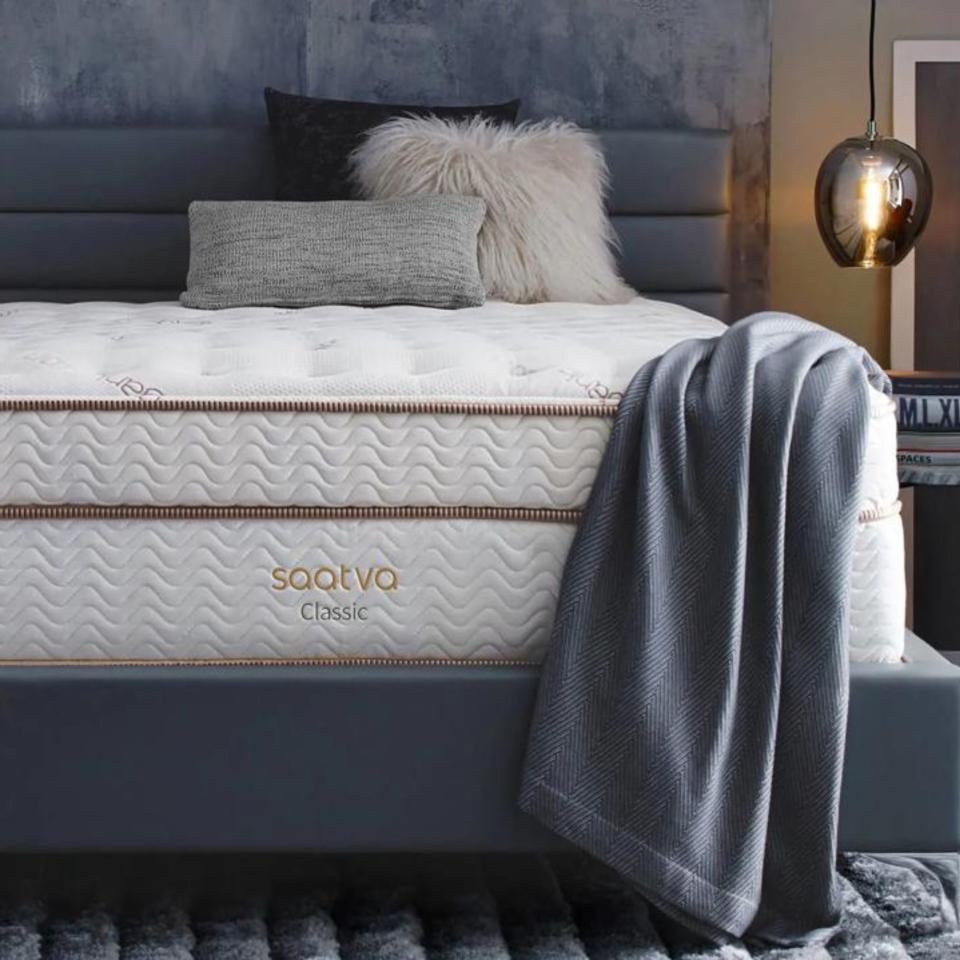Memory foam vs innerspring mattress - which is best?

Buying a mattress comes with a simple objective: better sleep. However, choosing the right one to achieve this can sometimes be a nightmare. A new bed needs to be both durable and supportive, but not too hard that it isn’t comfy - and all of these needs to be balanced with cost.
You may find yourself deliberating between foam and spring mattresses, which are the two most popular options. They are both designed to support all parts of your body equally, keeping your spine aligned during the night and avoiding discomfort upon waking.
Despite this, foam and spring mattress suit different types of sleepers. So while one person may rave about foam as a comfy base for slumber, another may feel more refreshed catching on spring.
In order to choose whether a foam or spring mattress is right for you, we’ll first explain what the qualities of each are and why they can be conducive to a seamless night’s snooze. We’ll also take you on a seamless journey through their specific pros and cons, and reveal which sleepers each are better suited to - equipping you with all the knowledge you need to find the best mattress.
What's the difference?
If you're in a rush, here's a table to quickly demonstrate the differences.
What's a memory foam mattress?

Memory foam mattresses haven’t been around as long as more traditional innerspring mattresses, but they’ve fast become a highly desired choice. A foam mattress usually has a foam core made from high-density foam, and can sometimes be topped with other foams that offer additional benefits to the sleeper.
Heard of memory foam? This new-age mattress material was invented back in 1966 by an aeronautical engineer tasked by NASA to improve their seats. It didn’t become available to consumers for the purposes of upgrading their snooze until the 1990s, but it has become a clear alternative to spring ever since.
What's an innerspring mattress?

Spring mattresses have been around a little longer than foam, and are therefore a tried-and-tested option. It revolves around a supportive core made from springs, topped with different materials such as foams and polyesters, all of which provide additional benefits for the sleeper.
What's a hybrid?
'A lot of the most popular innerspring mattresses are actually hybrids,' says Alex David, Head of eCommerce at Homes and Gardens. 'These use the classic innerspring construction with a memory foam top for the best of both types - innerspring coils for cooling and firm support and memory foam for reliving back and joint pain'.
Head to head
I'll go into this in more detail below, but for now, here's a direct comparison of our two favorite examples of these two types of bed.

Saatva Classic
The Saatva classic mattress is our number one mattress. Loved for its five-star features that balance supreme comfort and support, it's a hybrid mattress that will suit everyone – a great night guaranteed.
More details in our Saatva Classic mattress review
For
Mattress is made to order
Made with eco-friendly materials
Hassle-free white glove delivery and old mattress removal
Three firmness and two height options
Excellent edge support
Guardin™ botanical antimicrobial treatment to inhibit the growth of bacteria, mold, and mildew
Year-long trial and lifetime warranty
Against
$99 return fee
May be too firm for some

Nectar Original foam mattress
This popular mattress takes the top spot as our favorite memory foam option. It's amazing for aches and pains, and at an affordable price point. The only sticking points are poor edge support and that it easily forms depressions.
More details in our Nectar original foam mattress review
For
Not too soft, but not too hard - an even combination
Easy to assemble; comes in a box (no movers required)
Alleviates back and muscle aches
Solid motion isolation; good for partners
Lifetime Warranty
Against
Weak edge support
Easily forms impressions
What are the pros of a memory foam mattress?

As you can imagine, foam mattresses provide a high level of comfort. Memory foam in particular can mold to the shape of the body, facilitating proper spinal alignment. They also absorb movement, meaning you can avoid waking a partner if you have a tendency to toss and turn, and tend to be more durable - avoiding sagging or springs eventually poking through over time.
Memory foam is also a lot more convenient to buy. They can be rolled up, unlike innerspring mattresses, so they can be delivered right to your door. This also makes them much cheaper.
What are the cons of a memory foam mattress?
However, temperature regulation can be a significant downside to choosing foam. This thick, foamy material tends to trap heat, and because you sink down into it, the feeling is magnified. If you know you get hot in the night, you might want to avoid memory foam, although there are lots of memory foam beds out there with cooling materials like gels and copper.
Memory foam beds are much less durable than innerspring mattresses, too. After a few years they'll stop sprining back to shape, which makes them less supportive. The average lifespan is about 6-8 years, which is much lower than the 10-year average of an innerspring bed.
What are the pros of a spring mattress?

You can rely on a spring mattress to do its prime job - keeping the weight of your body evenly distributed - with impressive durability. The coils on an innerspring mattress will keep you comfortable and supported for years.
As its name suggests, there will be more bounce than with a memory foam mattress - which can feel preferable for some. What’s more, it facilitates better airflow and circulation and so it will keep you cooler if you tend to get hot at night, which is important since a lower body temperature is vital for a good night’s sleep.
What are the cons of a spring mattress?
That said, the guaranteed support provided by a spring mattress can also be its downside. These beds are heavy and inflexible, and wrangling them from a mattress store onto your bed can be a real headache.
Innerspring mattresses tend to be more expensive than memory foam beds thanks to the inclusion of springs. 'Because they can't be folded or rolled, they cost more to transport, too, and that cost is passed onto the consumer', says Alex.
Years down the line, there's always the chance a spring will buckle or become squeaky, which is always a hassle.
Buy a memory foam mattress if...
You're on a tighter budget
You love a soft bed
You want convenient delivery
You hate the sound of squeaky springs
Buy an innnerspring mattress if...
You want a firmer bed
You sleep hot
You've got a larger budget
You want a long-term investment
Mattress FAQS
Should I buy a latex mattress?
Latex mattresses are another type of mattress. Made from organic rubber, they're firm, and heavy. They're naturally hypoallergenic and fire retardant, but these qualities will cost you a lot.
What's a gel mattress?
Gel mattresses are a type of memory foam mattress. These mattresses use a layer of gel to counteract the heating effects of memory foam.
If neither of these work, a hybrid mattress of both types can be offer the best of both worlds, though it tends to be more expensive than a memory foam bed.

